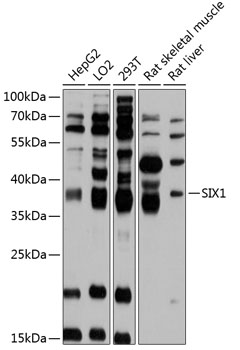-
Product Name
SIX1 Polyclonal Antibody
- Documents
-
Description
Polyclonal antibody to SIX1
-
Tested applications
WB
-
Species reactivity
Human, Mouse, Rat
-
Alternative names
SIX1 antibody; BOS3 antibody; DFNA23 antibody; TIP39 antibody; SIX homeobox 1 antibody
-
Isotype
Rabbit IgG
-
Preparation
Antigen: Recombinant fusion protein containing a sequence corresponding to amino acids 60-270 of human SIX1 (NP_005973.1).
-
Clonality
Polyclonal
-
Formulation
PBS with 0.02% sodium azide, 50% glycerol, pH7.3.
-
Storage instructions
Store at -20℃. Avoid freeze / thaw cycles.
-
Applications
WB 1:500 - 1:2000
-
Validations

Western blot - SIX1 Polyclonal Antibody
Western blot analysis of extracts of various cell lines, using SIX1 antibody at 1:3000 dilution.Secondary antibody: HRP Goat Anti-Rabbit IgG (H+L) at 1:10000 dilution.Lysates/proteins: 25ug per lane.Blocking buffer: 3% nonfat dry milk in TBST.Detection: ECL Basic Kit .Exposure time: 20s.
-
Background
Transcription factor that is involved in the regulation of cell proliferation, apoptosis and embryonic development. Plays an important role in the development of several organs, including kidney, muscle and inner ear. Depending on context, functions as transcriptional repressor or activator. Lacks an activation domain, and requires interaction with EYA family members for transcription activation. Mediates nuclear translocation of EYA1 and EYA2. Binds the 5'-TCA[AG][AG]TTNC-3' motif present in the MEF3 element in the MYOG promoter. Regulates the expression of numerous genes, including MYC, CCND1 and EZR. Acts as activator of the IGFBP5 promoter, probably coactivated by EYA2. Repression of precursor cell proliferation in myoblasts is switched to activation through recruitment of EYA3 to the SIX1-DACH1 complex. During myogenesis, seems to act together with EYA2 and DACH2 (By similarity). Regulates the expression of CCNA1.
Related Products / Services
Please note: All products are "FOR RESEARCH USE ONLY AND ARE NOT INTENDED FOR DIAGNOSTIC OR THERAPEUTIC USE"
